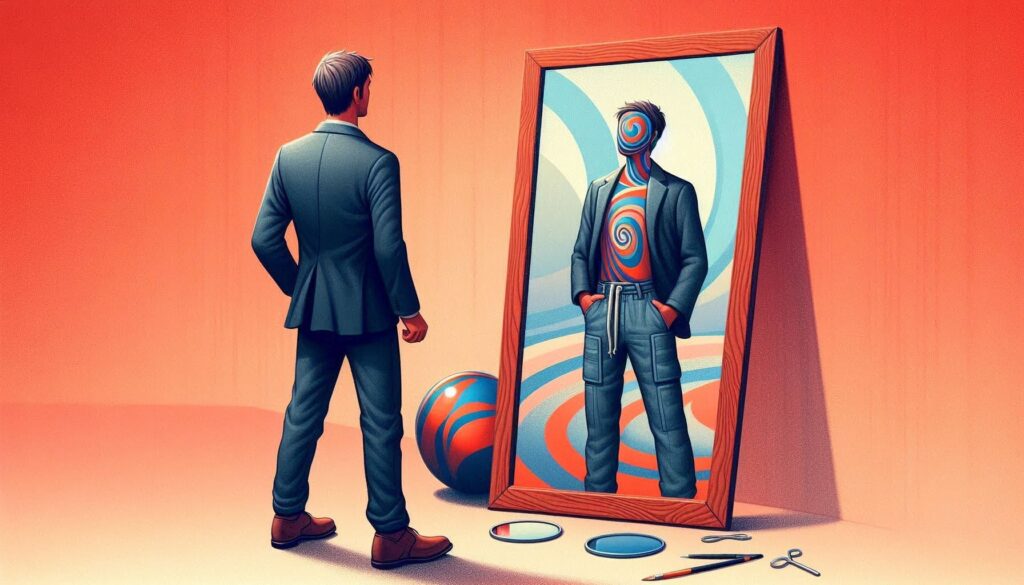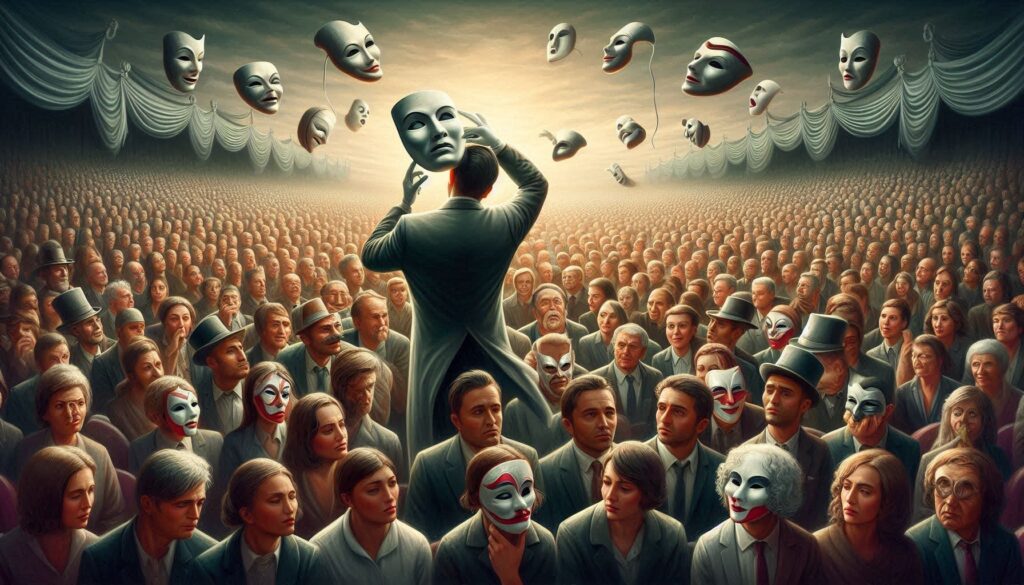
Introduction
Professional wrestling thrives on spectacle and drama, blurring the lines between reality and fiction. Central to this intricate performance is a concept called kayfabe—the art of presenting scripted events and personas as authentic. Derived from a carnival tradition, possibly originating from the phrase “protecting the secret,” kayfabe is the backbone of wrestling’s storytelling, where larger-than-life characters and intense rivalries captivate audiences who willingly suspend disbelief.
Kayfabe isn’t just about entertainment; it’s a carefully orchestrated illusion designed to evoke real emotions. Whether it’s Hulk Hogan’s heroism, The Undertaker’s mystique, or rivalries that spill outside the ring, kayfabe demands commitment to the narrative, on and off stage. Wrestlers maintain this illusion so meticulously that, for decades, fans debated whether the drama was real.
But the phenomenon of kayfabe isn’t confined to wrestling. It mirrors how we craft identities and narratives in everyday life, from curating social media profiles to navigating professional relationships. Like wrestlers, we adopt personas to fit roles, meet expectations, and protect vulnerabilities. This post explores the intriguing parallels between kayfabe and real life, uncovering how the art of illusion shapes not just the wrestling ring but the world around us.

Kayfabe in Wrestling
In professional wrestling, kayfabe is the art of maintaining the illusion that the personas, rivalries, and events within the ring are real. It’s the backbone of wrestling’s storytelling, requiring wrestlers to fully embody their characters both in and out of the ring. This commitment to kayfabe turns scripted rivalries into believable conflicts and transforms performers into larger-than-life figures.
Take The Undertaker, for instance—a character shrouded in mystery and darkness. From his supernatural-themed entrances to his eerie demeanor, Mark Calaway, the man behind The Undertaker, stayed in character for decades, even in interviews or public appearances. Similarly, Hulk Hogan epitomized the all-American hero, with his larger-than-life charisma and the unforgettable rallying cry of “Hulkamania.” Fans didn’t just watch these characters; they believed in them, cheering for their triumphs and lamenting their defeats.
By adhering to kayfabe, wrestling creates an immersive experience for its audience. The fans willingly suspend disbelief, entering a world where every feud, alliance, and betrayal feels authentic. Wrestlers’ commitment to kayfabe blurs the line between performance and reality, fostering an emotional connection with the storylines. Moments like Hulk Hogan’s clash with Andre the Giant or the infamous Montreal Screwjob resonate because of the deep emotional investment kayfabe enables.
However, there are moments when the illusion breaks—what fans call breaking kayfabe. This occurs when wrestlers or promotions acknowledge the scripted nature of wrestling, whether intentionally or accidentally. One notable example is the “Curtain Call” incident in 1996, when members of The Kliq—Shawn Michaels, Triple H, Kevin Nash, and Scott Hall—broke character in the ring to embrace, despite being portrayed as rivals. Such moments disrupt the narrative, but they also offer fans a glimpse into the real-life dynamics behind the spectacle.
While breaking kayfabe risks pulling fans out of the experience, it also highlights the art and effort behind wrestling. Kayfabe is more than just a tool for storytelling—it’s a testament to the performers’ dedication to creating a captivating illusion that blurs reality and fiction, leaving fans entertained and enthralled.

Kayfabe in Real Life
While kayfabe originated in professional wrestling, its essence extends far beyond the ring. At its core, kayfabe is about constructing and maintaining a persona that fits a specific narrative—a concept that resonates deeply in everyday life. Just like wrestlers embody characters to captivate audiences, people adopt roles to navigate social expectations, protect vulnerabilities, or pursue personal fantasies.
From childhood, we are conditioned to craft identities that align with societal norms. Parents, teachers, and peers shape our understanding of what is “acceptable” behavior. A child praised for being studious may grow up internalizing the persona of the diligent worker, even if they long for spontaneity. Conversely, someone labeled rebellious might lean into that identity, performing defiance even when they crave structure. These personas often evolve as we mature, shaped by experiences, ambitions, and the pressure to fit into various roles.
Consider the professional worker who meticulously maintains a polished image in the office but transforms into a carefree traveler on social media. Their Instagram feed is filled with scenic landscapes and adventurous captions, presenting a persona that may not fully align with their routine life. This curated identity satisfies a longing for freedom and adventure, while also appealing to followers’ admiration. Similarly, the extroverted partygoer who thrives in social gatherings might retreat into solitude at home, revealing their true introverted nature only in private.
These examples underscore how kayfabe plays out in daily life, creating a duality between public personas and private realities. On platforms like LinkedIn, people project confidence, competence, and ambition—carefully tailoring profiles to align with professional expectations. Yet, behind the scenes, they might struggle with imposter syndrome, stress, or self-doubt. In relationships, people often adjust their behavior to fit roles as partners, parents, or friends, sometimes masking their true feelings to maintain harmony or fulfill expectations.
The performative nature of these roles isn’t inherently negative. Just as kayfabe in wrestling provides entertainment and emotional connection, real-life kayfabe helps people navigate complex social landscapes. It allows individuals to protect their vulnerabilities, explore aspirations, and build relationships. However, problems arise when the gap between persona and reality becomes unsustainable. Living solely for the approval of others or suppressing one’s authentic self can lead to burnout, dissatisfaction, and identity crises.
The influence of social conditioning is crucial here. Society often rewards certain traits—confidence, charisma, and success—while stigmatizing vulnerability and failure. This creates pressure to construct personas that align with these ideals, even if they don’t reflect one’s true self. The key, then, is balance: recognizing when the kayfabe serves a purpose and when it’s time to drop the act.
In the end, kayfabe in real life is both a necessity and an art form. It helps us adapt to social environments, pursue ambitions, and connect with others. But it’s important to remember that, like in wrestling, kayfabe is just part of the story. True fulfillment comes from embracing the moments when we can step out of character, drop the illusion, and live authentically.

Influencers and Curated Kayfabe
In the age of social media, influencers embody the modern version of kayfabe. Unlike the average person, whose personality evolves naturally through experiences and relationships, influencers consciously craft their personas to appeal to specific audiences. They are not just sharing their lives; they are building a brand—an identity designed to captivate, inspire, or entertain.
This process often involves meticulously curating content that aligns with their chosen niche. A fitness influencer, for example, will showcase their perfect workouts, balanced meals, and motivational messages, while minimizing any struggles with motivation or indulgence. Similarly, a lifestyle influencer may post pictures of idyllic vacations or luxurious products, presenting a life of glamour that feels aspirational to their followers. Behind the scenes, however, the reality might be far less polished.
The pressure to maintain these curated personas can be immense. Influencers rely on their followers for engagement, sponsorships, and ultimately their livelihood, making authenticity a calculated risk. Every post is a performance designed to keep the audience invested, and breaking character—admitting to burnout, struggles, or contradictions—can risk alienating their base. This creates a self-perpetuating cycle where the influencer feels trapped by the persona they’ve built, unable to stray too far from the expectations they’ve cultivated.
Contrast this with the average person, whose identity evolves more organically. While many people also perform to some extent on social media—posting highlights of their lives or adhering to social norms—the stakes are usually lower. Their personality isn’t as rigidly constructed or monetized, allowing more room for authenticity and change.
In influencer culture, the line between reality and illusion becomes increasingly blurred. Followers often mistake the curated content for genuine life, forgetting that what they see is just one facet of the person behind the screen. Influencers themselves may struggle to separate their real identity from their online persona, as the boundaries between work and life dissolve.
This dynamic mirrors kayfabe in wrestling, where performers commit to their characters so deeply that the audience forgets they’re playing a role. Just as a wrestler’s persona exists to entertain, an influencer’s curated life exists to engage. Yet both raise the question: how much of the illusion is sustainable?
Ultimately, influencer culture highlights the dual-edged nature of kayfabe. It allows people to connect through aspirational narratives, but it also places enormous pressure on creators to uphold an illusion. Like wrestlers stepping out of character, influencers, too, must occasionally drop the façade to reconnect with their own truth—a challenging but necessary act in the quest for balance.

The Takeaway
Kayfabe, whether in wrestling or real life, reveals an undeniable truth: we all play roles to some extent. In wrestling, kayfabe creates unforgettable characters and storylines, while in everyday life, it helps us navigate complex social dynamics, meet expectations, and protect our vulnerabilities. But is this illusion inherently bad? Not necessarily. Like a wrestler’s performance, kayfabe can inspire, entertain, and foster connections when used responsibly.
However, the challenge lies in striking a balance between authenticity and performance. Maintaining a persona can be empowering—it allows us to project confidence, explore aspirations, or adapt to different environments. Yet, when the gap between our public and private selves grows too wide, it can lead to burnout, dissatisfaction, and a loss of identity. The key is knowing when to drop the act and reconnect with our true selves.
Kayfabe, at its best, is a tool—a way to engage with the world while safeguarding our core. At its worst, it becomes a trap, locking us into roles we no longer wish to play. Wrestling fans appreciate the spectacle, but they also cherish the rare moments when the curtain is pulled back, revealing the humanity behind the characters.
So, ask yourself: are you living your authentic self, or have you perfected your own kayfabe? The answer might just redefine how you navigate the roles you play every day.
